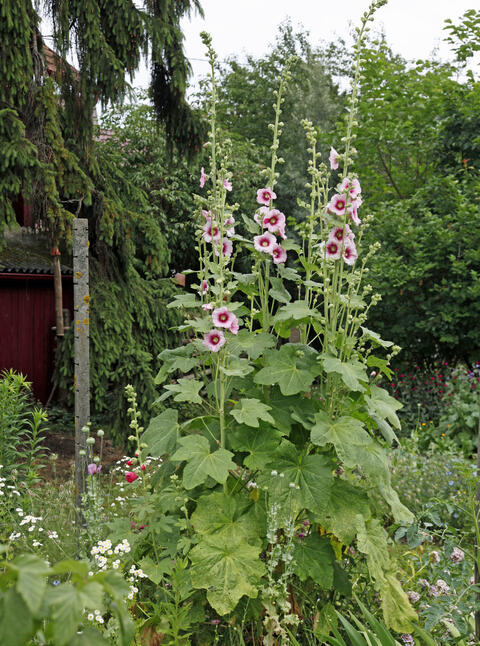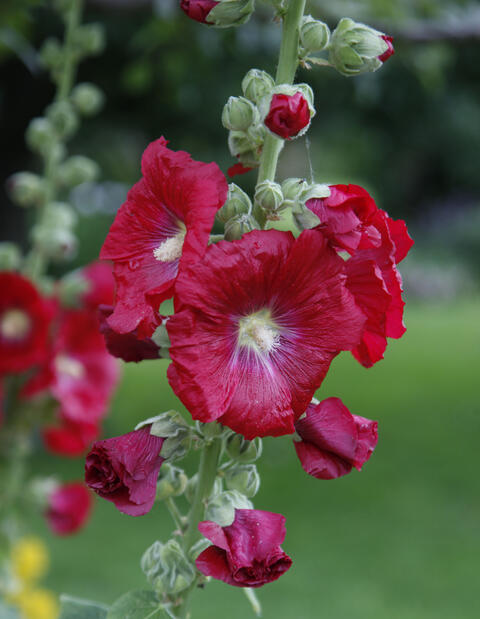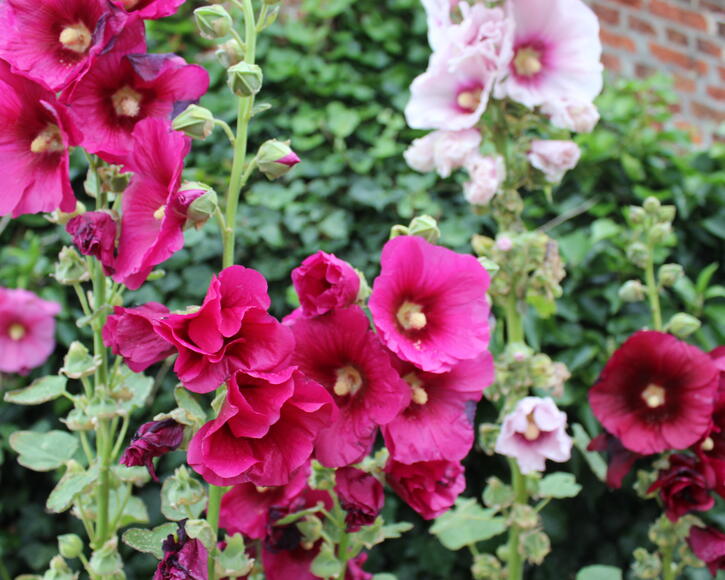Hollyhock
Hollyhocks add a special accent to flower beds in the summer with their tall inflorescences. Here’s how to settle the pretty summer bloomers in your garden.
Factsheet
- Growth type
-
- Perennial plant
- biennial or short-lived
- Growth height (from)
- from 180 cm to 200 cm
- Growth width (from)
- from 50 cm to 60 cm
- Growth characteristics
-
- upright
- rosette-forming
- Flower color
-
- purple
- yellow
- orange
- red
- pink
- white
- Flowering time (month)
-
- July to September
- Flower shape
-
- simply
- Uniflorous
- filled
- Leaf color
-
- green
- page format
-
- lobbed
- Light
-
- sunny to scattered light
- Soil type
-
- gravelly to loamy
- Soil Moisture
-
- dry to moderately humid
- ph value
-
- neutral
- Lime compatibility
-
- lime-tolerant
- Nutrient requirements
-
- nutrient-rich
- Humus
-
- rich in humus
- Decorative or utility value
-
- Flower Decoration
- Nectar or pollen plant
- Toxicity
-
- non-toxic
- Winter Hardness
-
- hardy
- Use
-
- Flowerbeds
- Bouquets
- Group planting
- Rose companion
- Garden style
-
- cottage garden
- Flower garden
- Heather Garden
- natural garden
- Rose Garden
- Bee Friendly
- bee friendly plant
Hollyhocks (Alcea) form their own genus with around 60 species within the mallow family (Malvaceae). They originate from the eastern Mediterranean and have been native to Europe and Asia for some time; they are used as a crop plant for medical purposes and to dye food stuffs. The common Hollyhock (Alcea rosea) is the most popular representative and is often used as a decorative plant in gardens. Mallows were already known as healing plants in ancient Rome. There, they were given the Latin name Alcea. Later, the Greek name Althea (= to heal) was used in the botanical nomenclature, which is why the hollyhocks are also known commercially under this name today.
Their tall growth of up to 7 feet is characteristic of hollyhocks. Hollyhocks are biennial, meaning in the first year they only form the leaf rosette; the long, straight stem grows from this in the second year. Spikes form on this with conspicuous, large flowers in many beautiful colors. The stalk of the Hollyhock is slightly branched, strong and grows bolt upright. The entire plant is lightly covered with prickly hairs.

The multi-lobed, light green leaves of the hollyhock rise from a basal leaf rosette. The leaves grow up to 6.3 inches long and are slightly hairy. They also sit on hairy stems. Alternating leaves grow on the flower stem in the second year.
The strong, palm-sized Hollyhock flowers appear from July to September. There are both single and double-flowers in a wide variety of colors, from white to yellow, apricot, pink and red and even violet and purple-black. Tip: Single-flowering varieties are longer-lasting than double-flowered Hollyhocks.

Hollyhocks like a nutrient-rich, permeable and dry to slightly moist soil. They love full sunlight. The best location to choose for your Hollyhock is a sunny flower bed with permeable soil. Stocks which are too closely sown or planted should be thinned in good time to ensure they can develop more strongly as individual plants. The leaves will also dry off better and are less prone to Hollyhock rust.
Hollyhocks are actually perennials. However, as they expend a lot of energy when flowering, the blossoms fade considerably from year to year. This means it is better to prune plants which have finished flowering and ensure continuous rejuvenation through seed sowing. Achieve this by sowing Hollyhocks directly in a flower bed in the fall or from June. If you already plant ready grown, young plants in early fall, the Hollyhock can develop well before it flowers in the following year.
Plant Hollyhocks with sufficient distance between the plants so that the leaves can dry out quickly after a rainfall. Give the Hollyhock plenty of compost in the following year. This fast growing plant requires plenty of water in the summer. A protective layer of mulch is advisable to prevent the soil from drying out too quickly. Support the long stems in exposed locations with a stable rod, as Hollyhocks bend easily in the wind.

Hollyhocks can also be pre-grown in propagator trays. Here, the seeds are placed in a loose substrate, covered with some soil (!) and watered. The first seedlings appear after two to three weeks and these then need to be separated. The young plants only form leaves in the first year. In the following spring, they start with a well developed rosette and then display their full flowerage all summer long. Tip: Don’t wait too long to separate and plant them out: Hollyhocks like to grow deep roots and the flat propagator trays quickly become too restrictive.
Pruning after flowering prevents unwanted self-sowing and increases the flowering period. Tip: Biennials normally die after the seeds have matured. If you shorten the plants straight after flowering, this often leads to a renewal of the leaf rosette and further flowering in the subsequent year.
Hollyhocks are biennials and normally do not require winter protection. The part of the plant above the earth dies in winter and can be cut off. The plant will reshoot in the coming spring. If you want to be extra sure, you can cover the Hollyhock with foliage or brush wood during frosts.
Hollyhocks are popular cottage garden plants. As they require something to lean on, a shrub bed is only suitable as a location if there is sufficient support. However, Hollyhocks are very effective in front of light colored house walls, walls or along fences and are an attractive background for shrub and flower beds. They also look great planted in groups along edges and ensure dabs of color at lofty heights. Tip: Mix the black flowering with pastel colored varieties.

With their long-lasting flowers, hollyhocks are a great accompaniment to Sun flowers, and Roses in romantic country house gardens. The long Hollyhock panicles also look great as cut flowers. Extend flowering time in a vase by removing the leaves from the Hollyhock flower stem and dipping the end of the stalk in boiling water for 40 seconds.
‘Polarstar’ (with a yellow eye) and ‘Mars Magic’ (red) belong to the single flowering, long-lasting Spotlight series.. The ‘Nigra’ Hollyhock flowers in dark purple to almost black. Whereas the flowers of the Hollyhock variety ‘Champagne’ are characterized by fine color nuances from creme-white to apricot. They are suitable for pots and grow to around 5.6 feet tall. The red-violet, double-flowers of the ‘Cassis Swirl’ Hollyhock are slightly reminiscent of English roses.

Tip: The Hollyhock (Alcea rosea) and Marsh mallow (Althaea officinalis) cross from the Hungarian breeder Kovats is longer-lasting than the common Hollyhock. These cross breeds (x Alcalthaea suffrutescens) include the well-known varieties ‘Parkallee’ (light yellow, semi-double), ‘Parkfrieden’ (light pink) and ‘Parkrondell’ (dark pink, semi-double). Their flowers are somewhat smaller than the common Hollyhock, but the plants are more stable and less susceptible to hollyhock rust. Note: These hybrids are not available commercially as sowing seeds but as young, potted plants.
Hollyhocks readily self-sow. You can promote self-sowing by leaving the seed heads to stand over the winter and only removing them the following spring. Alternatively, you can collect the seeds and put them in a specific position. A sure sign of mature Hollyhock seeds are dry capsules which are already opening or can be easily pushed open. The individual seeds are very small, brown colored and can be easily separated. If the seeds are sown directly after collection in August or September, the Hollyhocks form a strong rosette in the following year, followed by flowering. Seeds can still partially germinate in the fall and already flower the following year, depending on the region, weather, seeds and several other factors. Alternatively, they can be sown directly in a pre-prepared bed up to late spring or early summer.
The main disease for hollyhocks is Hollyhock rust (Puccinia malvacearum), with occurs so frequently that it almost forms an integral part of the hollyhock. It affects the leaves in particular and can be recognized from yellow flecks and reddish-brown pustules (sporocarps) on the underside of the leaf. Hollyhocks become increasingly bare, even if the plants continue to flower.

In the event of an infestation, continuously remove infected leaves and dispose of these in the household waste. A fungicide prevents further spreading. In the fall, the plant should be completely cut back and earthed up. This earth and the first new leaf shoots should also be removed in the spring. You can prevent a Hollyhock rust infestation by planting Hollyhocks with sufficient distance in a suitable, ventilated location and never pouring water on the leaves.
Frequently Asked Questions
What is a Hollyhock?
Hollyhocks (Alcea) are popular cottage garden plants consisting of around 60 species which form a genus in the Mallow (Malvaceae) family. The best-known representative is the common Hollyhock (Alcea rosea).
What does a Hollyhock look like?
The Hollyhock is characterized by tall growth of up to seven feet. The large, multi-lobed leaves are colored light green. The often palm-sized flowers appear from July to September. The color palette ranges from white and yellow to apricot, pink and red, as well as violet and purple-black.
When can Hollyhocks be sown?
Hollyhocks in late summer, directly in a flower bed.
When can I plant Hollyhocks?
Pre-grown young plants are best planted in the bed already in the fall, so that the plants can develop well before they decorate the garden with their flowers the following year.
When can Hollyhocks be pruned?
Hollyhocks can be pruned back directly after flowering. In this way, you can prevent self-sowing and also extend the lifetime of the plant.

